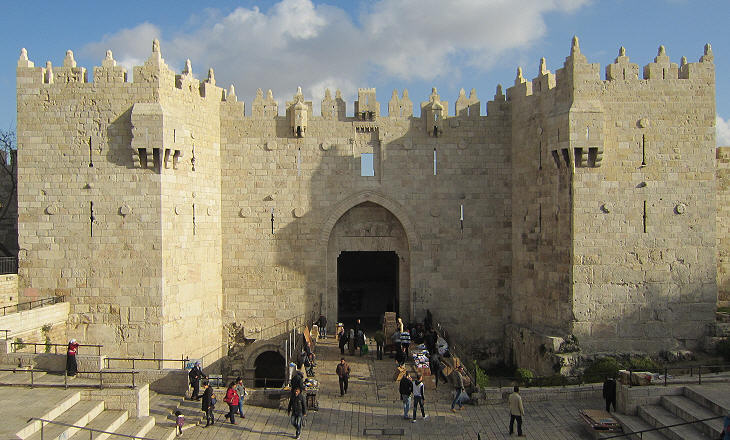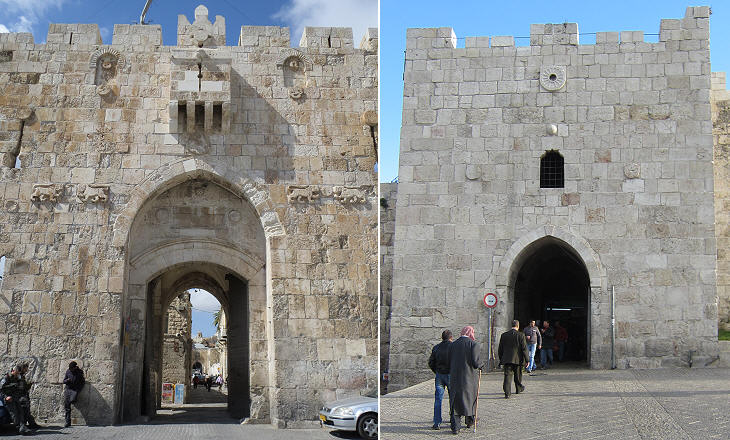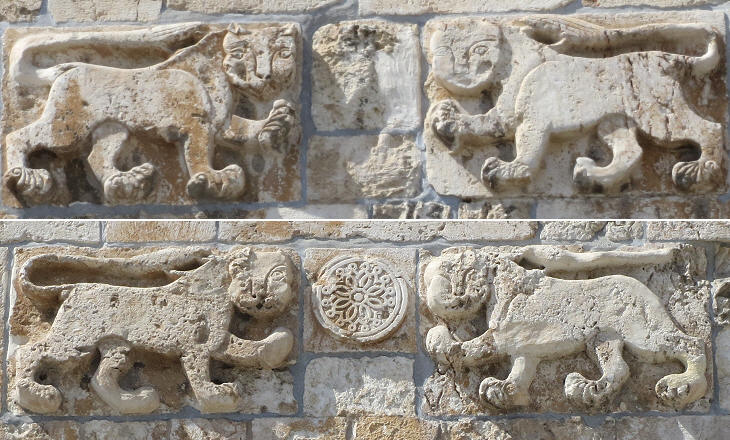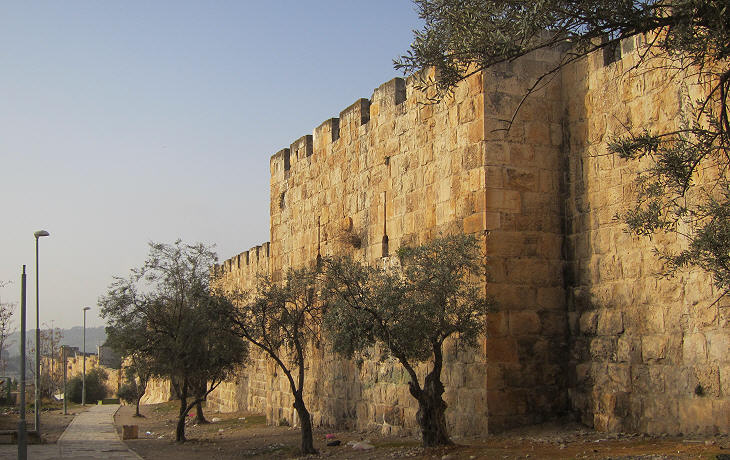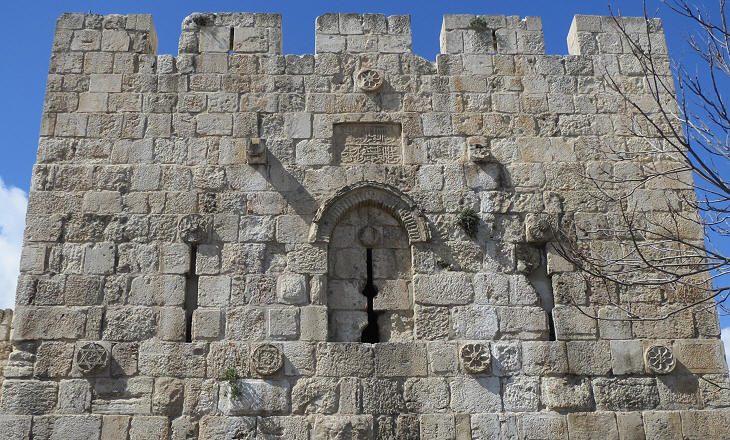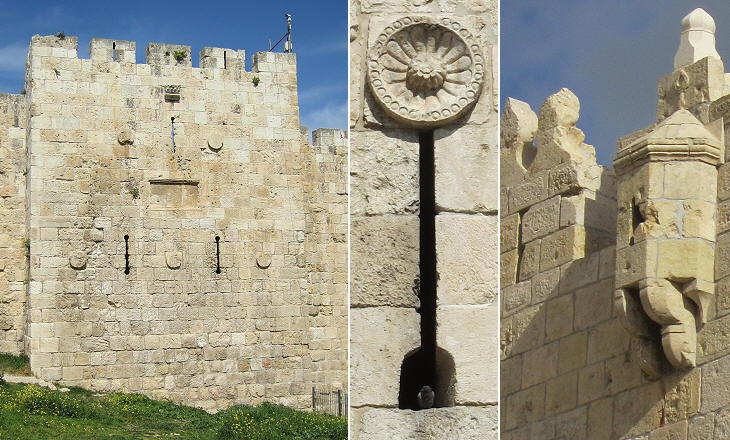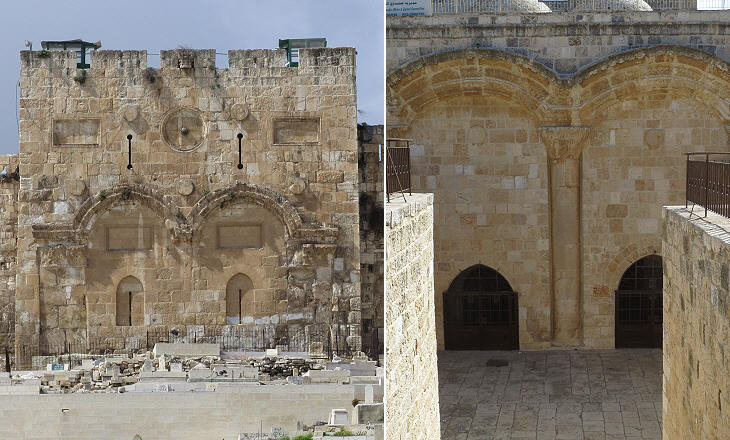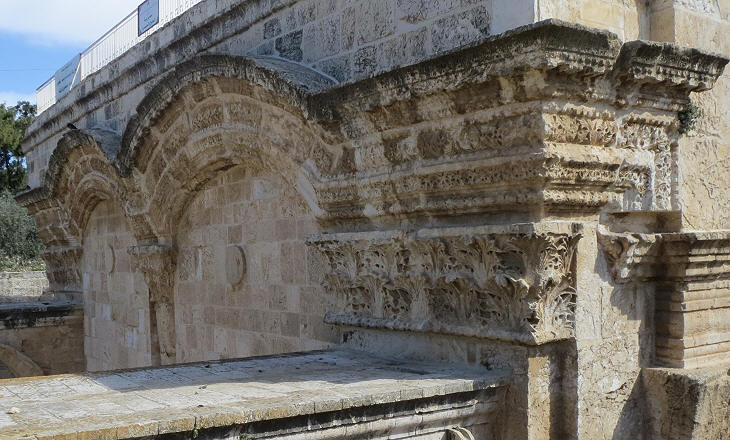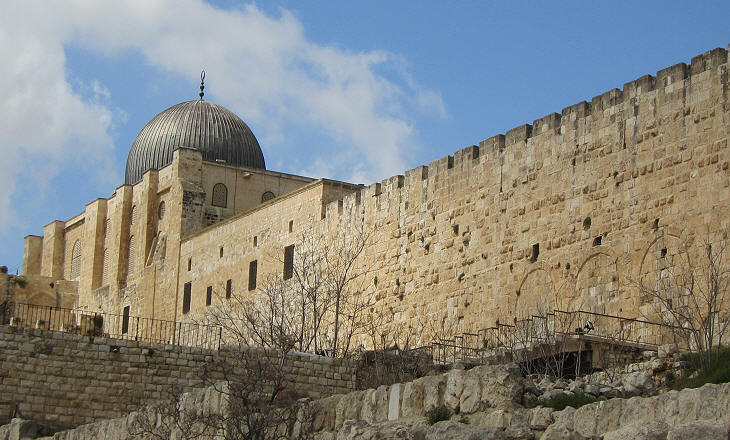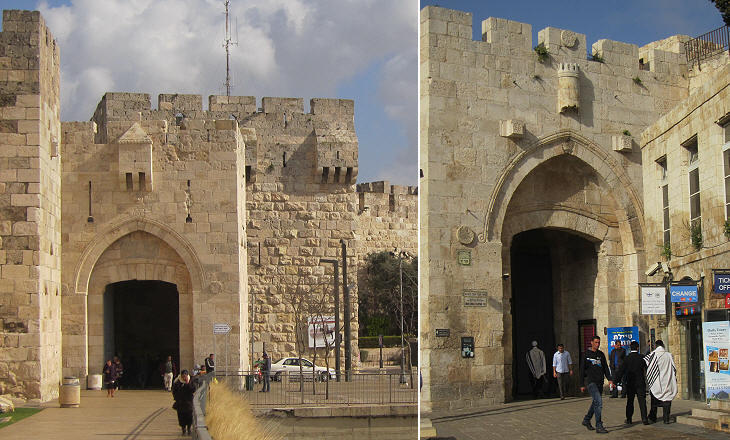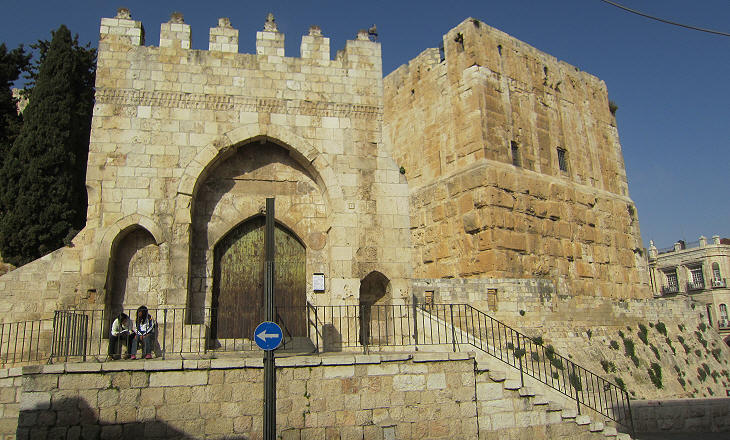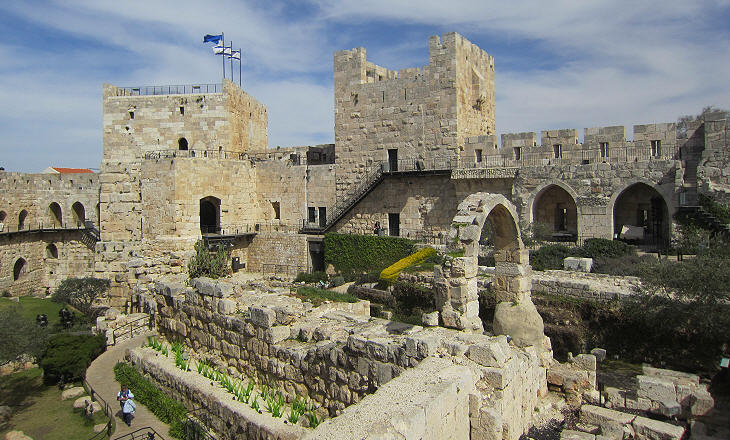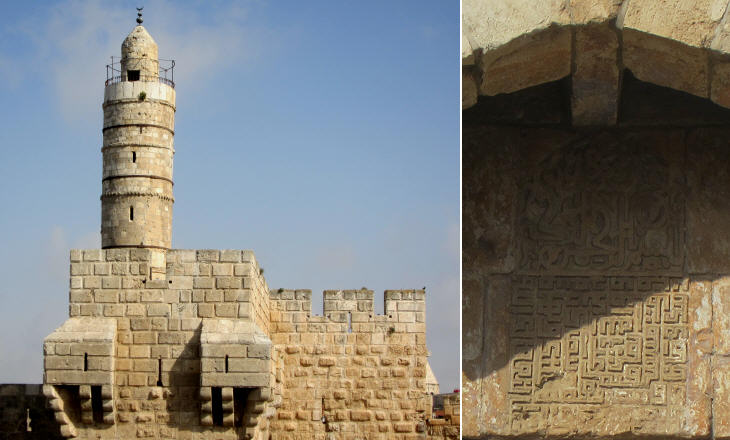  What's New! Detailed Sitemap All images © by Roberto Piperno, owner of the domain. Write to romapip@quipo.it. Text edited by Rosamie Moore. Page added in May 2013. |
 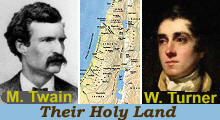 - Jerusalem - The Walls - Jerusalem - The Walls
If you came to this page directly, you might wish to read a page with an introduction to this section first. At five minutes past ten I first saw the Holy City, even the Turks call it so, which we entered at twenty minutes past ten by the most complete neck breaking road that ever man passed over. I first saw it from a hill commanding it which I descended to enter it by the gate of Damascus. It presented a confused view of trees, roofs of houses and domes among which were conspicuous those of the Mosque of Omer occupying the site of Solomon's Temple and of the Holy Sepulchre. On entering the gate (..) I rode immediately to the Roman Catholick convent of San Salvador. (..) (The monks) welcomed me most cordially. They expressed the greatest astonishment on hearing that I had come (from Nazareth) through Samaria and told me I was the first European who had come by that road in a Frank dress for many years. William Turner - Journal of a Tour in the Levant - 1820 At last, away in the middle of the day, ancient bite of wall and crumbling arches began to line the way - we toiled up one more hill, and every pilgrim and every sinner swung his hat on high! Jerusalem! Perched on its eternal hills, white and domed and solid, massed together and hooped with high gray walls, the venerable city gleamed in the sun. So small! Why, it was no larger than an American village of four thousand inhabitants, and no larger than an ordinary Syrian city of thirty thousand. Jerusalem numbers only fourteen thousand people. Mark Twain - The Pilgrims Abroad - 1869
Just after noon we entered these narrow, crooked streets, by the ancient and the famed Damascus Gate, and now for several hours I have been trying to comprehend that I am actually in the illustrious old city where Solomon dwelt, where Abraham held converse with the Deity, and where walls still stand that witnessed the spectacle of the Crucifixion. M. Twain The Gate of Damascus was rebuilt in 1536-42 by Ottoman Sultan Suleyman I in the frame of an overall reconstruction of the walls. It is the finest gate of the city and it stands on the site of a triumphal gate of Aelia Capitolina, the town built by Emperor Hadrian on the ruins of Jerusalem which had been destroyed when it was seized by Titus, Emperor Vespasian's son in 70 AD. You may wish to compare the walls and gates of Jerusalem with those of Damascus.
The gates are five: that of David south, of Bethlehem south west, of Bab Isbot, the name has no meaning, south east, of Damascus north, of Our Lady Mary north east. Besides these is the Golden Gate on the east wall, but this is now shut up. W. Turner The gates ot Jerusalem, have several names. Gate of Our Lady Mary was so named because it led to the Tomb of Mary, but today it is best known as Lion Gate because of the reliefs which decorate it. Turner did not mention Herod's Gate, which perhaps was shut when he visited Jerusalem.
Most texts attribute the reliefs portraying lions to Mameluke Sultan Baibars who conquered the Holy Land in the XIIIth century. His heraldic symbol was a lion (see that at Nimrod Castle), but he was not the only ruler who was associated with lions and similar reliefs can be seen elsewhere, as at Silvan, a town in south-eastern Turkey.
Overall the walls of Jerusalem are in pretty much the same condition that they were when Turner and Twain visited the city. Their surroundings instead have significantly changed because of the development of the modern city. The eastern side, thanks to the presence of cemeteries, is the only one where it is possible to walk along the walls without the noise of traffic.
When Sultan Suleyman ordered the reconstruction of the walls he did not fear an enemy would ever lay siege to Jerusalem, because they do no not include bastions, outer works, battlements for the placement of guns and other features which were required by cannon warfare.
I set out from the gate of David (aka Sion Gate) to walk round the city which I accomplished at the rate of about three miles an hour in forty seven minutes. I judged from the time it took me that Maundrel's computation of two and a half miles for the extent of the walls is tolerably correct. The walls were so irregular that I could hardly judge of their form, but I should think them an irregular heptagon. They have square towers at regular intervals. W. Turner A fast walker could go outside the walls of Jerusalem and walk entirely around the city in an hour. I do not know how else to make one understand how small Jerusalem is. Twain
The Moslems watch the Golden Gate with a jealous eye, and an anxious one, for they have an honored tradition that when it falls, Islamism will fall and with it the Ottoman Empire. It did not grieve me any to notice that the old gate was getting a little shaky. M. Twain In 1853 the Ottoman Empire was referred to as "the sick man of Europe" by Tsar Nicholas I and Twain had this sentence in mind when he wrote about the tradition of the Golden Gate (which was similar to that regarding the Colosseum in Rome).
The Golden Gate gave direct access to the great terrace where the Temple stood and which after the destruction of the latter housed pagan temples, churches and eventually mosques. Its design clearly indicates that it was a Byzantine ceremonial gate which was used for processions. The Ottoman reconstruction did not alter its original design.
The area of the Temple had other ceremonial gates which all were walled up by the Ottomans. Excavations have been carried out along the southern walls to unearth stairs which Jewish pilgrims utilized to access the Temple before its destruction.
Aelia Capitolina had two main cardi (north-south streets) which from Damascus Gate reached the southern walls near the Temple and on Mount Sion (see an ancient map - it opens in another page). Bab al-Magharibeh, so named after migrants from Maghreb (North-western Africa) who lived in the area, was referred to as "Bab Isbot" by Turner. It is situated near the Temple on the site of the ancient gate. When Turner visited Jerusalem Sion Gate was known as David's Gate because it leads to the assumed tomb of the king. It does not correspond to the Roman gate which was located to its east.
Jaffa Gate is the only gate on the western side of the walls and at Turner's time the road to Bethlehem started from this gate which was named after it, rather than after Jaffa. It is a typical elbow-shaped gate upon which Ottoman Sultan Abdul Hamid II built a clock tower in 1908. It was pulled down by British authorities in 1922.
This morning early I walked about the city with Signor Matthia, the dragoman (interpreter) of the convent, to visit the remarkable places within the walls of the city. We went first to the castle which I inspected after having obtained leave from the Aga (commander) of it. The pilgrims are not admitted here. It is large and might be strong, but like most old buildings in the hands of the Turks is falling to ruins. The fosse is now dry and apparently has long been so for a large olive tree flourishes in it and of only thirteen cannon that I saw few have serviceable carriages. From a minaret in the castle I had a commanding view of the city and observed the situation of the leading buildings. W. Turner
The Citadel was the only state-of-the-art Ottoman fortification of Jerusalem. It was designed with projecting bastions, a moat and outer works. Its integrity has been disrupted by massive excavations aimed at finding the layers of previous fortifications which include walls of all the periods of the history of the city. The overall result of the excavations is a matter for discussion. They were mainly aimed at finding evidence of the pre-Roman city, but this approach may lead to decisions which in the long period could be regretted (in Italy we now regard what was done at Mausoleo di Augusto in the 1930s as an unwise decision).
The image used as background for this page shows a tower of the Citadel. See these other pages on Jerusalem
Move to: Introductory Page Nimrod Castle Banias (Caesarea Philippi) Acre (Akko) Turner's excursion to Kaifah (Haifa) Tiberias Holy sites in Galilee Nazareth Jaffa A Glimpse of Tel Aviv  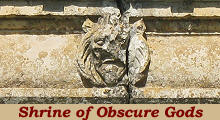 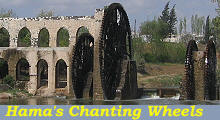 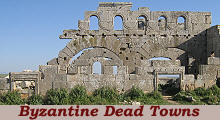 |
